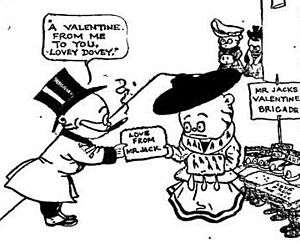Mr. Jack

Mr. Jack was an American comic strip by Jimmy Swinnerton which ran in William Randolph Hearst newspapers from about 1903 until 1935. He may be the first developed "funny animal" character, a type that has since become a staple in the comics medium. The series may also be one of the earliest spin-offs of another comic strip. The character of Mr. Jack, a philandering playboy tiger, emerged around 1898 in Swinnerton's earlier Hearst feature, The Little Tigers, which started in 1896.
History
Jimmy Swinnerton began his career in 1892 as a young illustrator for the San Francisco Chronicle, one of William Randolph Hearst's newspapers. He began illustrating the weather section with a cute bear cub, which proved popular enough that Swinnerton's bears soon appeared throughout the paper. This feature, known as The Little Bears, is apparently the first American comic strip with recurring characters.[1]
Swinnerton's talents drew attention in the Hearst chain, and in 1896 he was invited to draw cartoons for The New York Journal. Apparently at Hearst's request, he shifted his characters from bears to tigers, the emblem of Tammany Hall, creating The Little Tigers.[1][2] At first fairly generic, over time individual characters began to emerge, the most popular being the womanizing playboy "Mr. Jack", who first appeared around 1898. Mr. Jack got his own Sunday strip starting on November 1, 1903.[2] While previous animal characters in art and fiction were often given some human features, such as clothing and speech, Swinnerton went a step further with Mr. Jack by giving him an essentially human body below his tiger head, complete with hands rather than paws and an upright stance. As such, comics historian Don Markstein wrote that he was probably "the first fully-realized funny animal", a character type that would soon become very well established in comics and other media.[2][3]
Jack's rakish ways made him a target of protests that he was a bad example for children, and after 1904 his strip was moved to the sports section, seen as a more adult and male area of the paper. It also ran less frequently, as Swinnerton focused on his new strip, the more popular Little Jimmy. Jack got a daily strip, The Escapades of Mr. Jack, which ran from 1912 until at least 1919. The latter date is given in some sources for Swinnerton's work, though Markstein notes that some later strips depicting Jack surreptitiously drinking alcohol behind the backs of police officers appear to date them to the Prohibition era of the 1920s. In 1926 Mr. Jack's strip became a topper above Little Jimmy and was toned down. It ran until 1935, when it was discontinued.[2] Swinnerton continued to draw Little Jimmy until 1958, and died in 1974.[1]
Characters and story
The central character is Mr. Jack, a married but philandering tiger who would flirt with any nearby lady. His long-suffering spouse, "Wifey", who often has to beg forgiveness for her husband's misbehavior, only to beat him senseless afterward. Though his shameless behavior is usually punished, generally by his wife or the boyfriends of his victims, he generally concludes that it was all worth it. On a whole, a very popular figure among less conservative characters in his universe, Mr. Jack is often seen as the jovial life of the party, charming to women and admired by men.
Influence
Mr. Jack, while never as popular as Little Jimmy, probably also because of its erratic appearances, still had a considerable influence. One clear derivative was Mr. George by Harold Knerr, the second author of the Katzenjammer Kids.[4]
References
- 1 2 3 Markstein, Don. "Jimmy Swinnerton". Don Markstein's Toonopedia. Archived from the original on March 9, 2015. Retrieved July 3, 2013.
- 1 2 3 4 Markstein, Don. "Mr. Jack". Don Markstein's Toonopedia. Archived from the original on April 15, 2012. Retrieved July 3, 2013.
- ↑ Holmes! (2005-11-16). "New strip! Mr. Jack!". Barnacle Press. Archived from the original on 2007-04-06. Retrieved 2007-05-14.
In 1892, Swinnerton unleashed a series of bears and tigers, standing on two feet and dressed in the styles of the day, setting off an explosion of anthropomorphic animals that we've yet to tire of.
- ↑ Jim Lowe (2002-06-25). "Harold H. Knerr". Retrieved 2007-05-14.